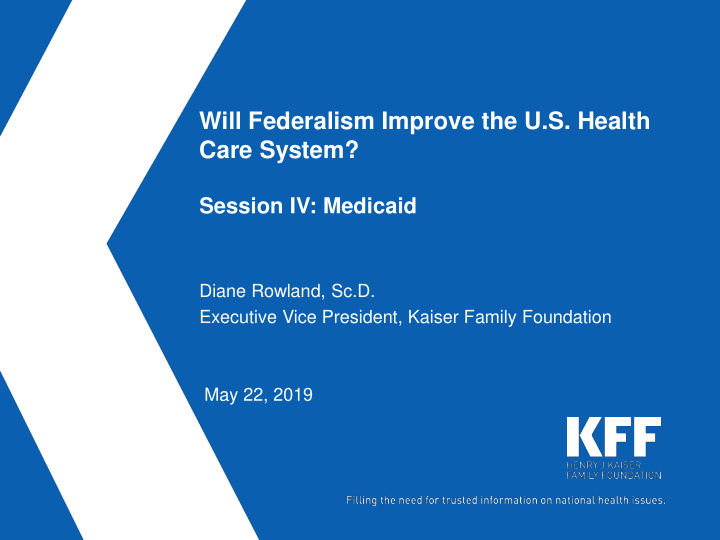



Will Federalism Improve the U.S. Health Care System? Session IV: Medicaid Diane Rowland, Sc.D. Executive Vice President, Kaiser Family Foundation May 22, 2019
Figure 1 Medicaid’s Framework Eligible Individuals are entitled to a defined set of benefits Entitlement States are entitled to federal matching funds Federal State Flexibility to Sets core administer the requirements on program within eligibility and Partnership federal guidelines benefits
Figure 2 Medicaid’s Evolution Millions of Medicaid Beneficiaries 80 HCBS waivers 70 authorized 60 Section 1115 waivers expand Medicaid eligibility 50 “Katie Beckett” Implementation of 40 Medicaid ≠ option the ACA Medicaid Welfare 30 expansion 20 Olmstead 10 Decision 0 1972 1977 1982 1987 1992 1997 2003 2008 2015* Managed SSI SCHIP ACA Medicaid eligibility for Care enacted enacted enacted women Extended and children is expanded
Figure 3 Medicaid’s Role Health Insurance Coverage Assistance to 10 million > 50% Long-Term Care For 1 in 5 Americans Medicare Beneficiaries Financing MEDICAID Support for Health Care System State Capacity to Address Health and Safety-Net Challenges
Figure 4 Federal Rules/State Options Benefits Delivery Systems / Eligibility Provider Payments Federal Standards Premiums / Cost Waivers Sharing
Figure 5 Traditional Federal – State Financing VT WA ME ND MT NH MN MA NY OR WI SD RI ID MI CT WY PA NJ IA NE OH DE IN IL NV MD UT WV VA DC CO KS MO KY CA NC TN OK SC AR AZ NM GA AL MS LA TX AK FL FFY 2020 FMAP 50% (13 States) HI 50.1-59.9% (11 States) 60.0-69.9% (17 States) 70.0-77.0% (10 States including DC) NOTE: FMAP percentages are in effect Oct. 1, 2019-Sept. 30, 2020. SOURCE: Federal Register, November 28, 2018 (Vol 83, No. 229)
Figure 6 Common Framework ↔ State Variation Available Revenue: per capita income, total taxable resources, tax collections Demand for Public Services: poverty, unemployment, need for health services (coverage, age, disability, chronic MEDICAID conditions) SPENDING VARIES ACROSS Health Care Markets: employer premiums, Medicare STATES spending per enrollee, primary care shortage areas, supply of providers and health facilities Medicaid Policy Choices: eligibility levels, benefits, payment and delivery system choices, long-term care delivery systems Budget and Policy Process: political affiliation of Governor and legislature, legislative sessions, state budget process SOURCE: Why Does Medicaid Spending Vary Across States: A Chart Book of Factors Driving State Spending, KCMU, November 2012.
Figure 7 Where is the Right Balance? National State Standards Flexibility
Recommend
More recommend